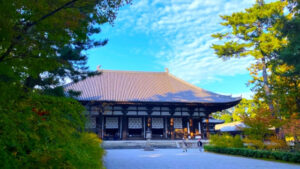Manpukuji Temple: A Zen Oasis in Kyoto
Nestled in the heart of Kyoto, the cultural capital of Japan, lies the tranquil Manpukuji Temple. This temple, also known as Obaku-san Manpuku-ji, is a hidden gem that offers a unique blend of Chinese and Japanese Zen Buddhism, making it a must-visit for any spiritual seeker or history enthusiast.
History and Architecture
Founded in 1661 by the Chinese monk Ingen Ryuki, Manpukuji Temple serves as the head temple of the Obaku sect of Zen Buddhism in Japan. Ingen Ryuki, who hailed from Fujian province in China, brought with him the teachings of the Ming Dynasty’s Linji school of Zen, which later evolved into the Obaku sect in Japan.
The temple’s architecture is a testament to its Chinese roots. Unlike most Japanese temples, Manpukuji features a symmetrical layout, with the main hall, Buddha hall, and Dharma hall all aligned on a north-south axis. This layout is characteristic of Ming Dynasty architecture and is a rare sight in Japan.
The main gate, known as the Sanmon, is a two-story structure that houses various Buddhist statues and is considered one of the three most beautiful temple gates in Kyoto. The temple complex also includes a five-story pagoda, a bell tower, and a drum tower, all of which are designed in the Chinese style.
Spiritual Practices
Manpukuji Temple is not just a historical site; it’s a living, breathing spiritual center. The temple continues to uphold the practices of the Obaku sect, which combines Zen meditation with Pure Land Buddhism’s emphasis on chanting the name of Amitabha Buddha.
Visitors can participate in zazen meditation sessions, sutra copying, and other Buddhist practices. The temple also hosts a vegetarian cooking class, where participants can learn to prepare shojin ryori, a type of vegetarian cuisine traditionally served in Buddhist temples.
Cultural Significance
Manpukuji Temple has played a significant role in shaping Japanese culture. The Obaku sect has influenced various aspects of Japanese art and culture, including tea ceremony, calligraphy, and haiku poetry. The temple’s influence is particularly evident in the world of tea ceremony, where the Obaku style, known as “Sencha-do,” continues to be practiced.
Visiting Manpukuji Temple
Access
List of Access
Manpukuji Temple is easily accessible from various parts of the country. Here are some of the most common routes:
From Tokyo to Kyoto
- Flight: Approximately 1 hour and 20 minutes, with an average price of $114.80.
From Osaka to Kyoto
- Flight: Approximately 3 hours and 30 minutes (including a layover), with an average price of $206.50.
From Nagoya to Kyoto
- Flight: Approximately 30 hours and 45 minutes (including two layovers), with an average price of $1275.60.
Once you reach Kyoto, you can take the city bus, subway, or JR train to Manpukuji Temple. The temple is a short walk from the Obaku Station on the JR Nara Line.
Accommodation Options
Here are three accommodation options near Manpukuji Temple:
- Onyado Nono Kyotoshichijo Natural Hot Springs
- Located in Central Kyoto, this spa hotel is within a 10-minute walk of Kyoto Station Building and Kyoto Tower.
- Offers a full-service spa, a restaurant, and a sauna.
- Average nightly price: $125.45.
- Hyatt Regency Kyoto
- Located in Higashiyama Ward, this luxury hotel is within 1 mi (2 km) of Sanjusangen-do Temple, Kiyomizu Temple, and Kyoto Tower.
- Offers 3 restaurants, a full-service spa, and a health club.
- Average nightly price: $297.60.
- Hotel Kanra Kyoto
- Located in Central Kyoto, this spa hotel is within a 10-minute walk of Higashi Honganji Temple, Shoseien Garden, and Kyoto Tower.
- Offers a full-service spa, a restaurant, and massage/treatment rooms.
- Average nightly price: $246.67.
Please note that the opening hours of Manpukuji Temple are from 9:00 am to 5:00 pm. The temple is open to the public year-round.
Remember to check the official website or local sources for the most accurate and up-to-date information. Enjoy your visit to Manpukuji Temple!
Conclusion
Manpukuji Temple is a place where history, culture, and spirituality intertwine. Its unique blend of Chinese and Japanese Zen Buddhism, its significant influence on Japanese culture, and its tranquil atmosphere make it a standout among Kyoto’s many temples. A visit to Manpukuji Temple is a journey into the heart of Zen Buddhism and a step back in time to the era of the Ming Dynasty. It’s a place that invites contemplation and offers a peaceful retreat from the hustle and bustle of modern life.









